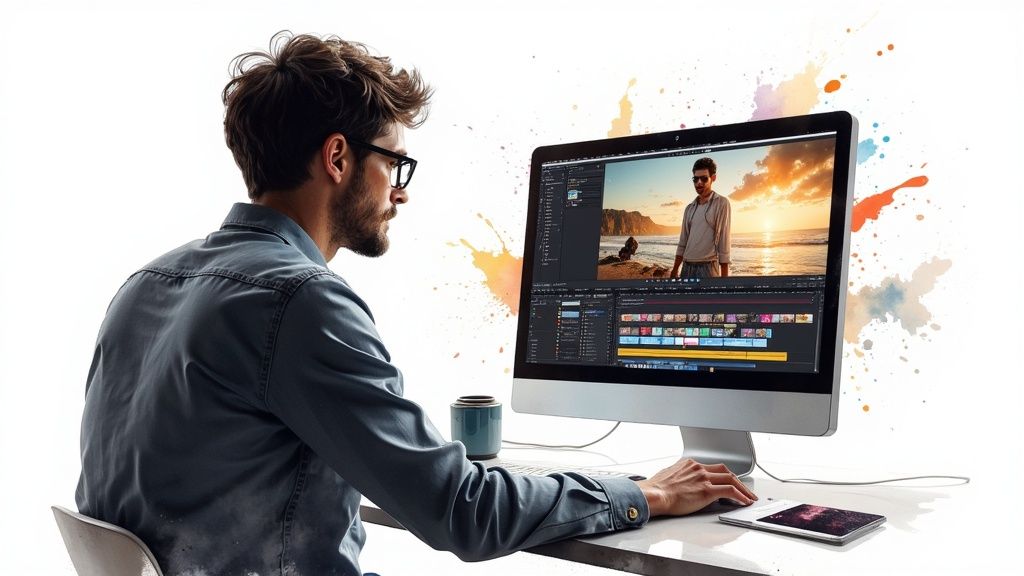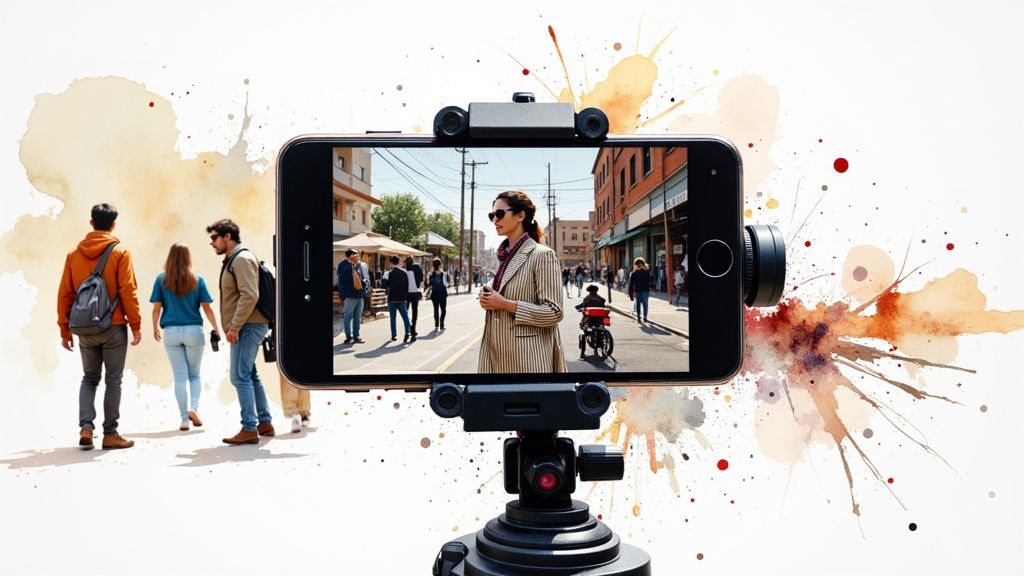Mastering Mobile-First Video Optimization

Most people now watch videos on their phones and tablets, making mobile optimization essential for social media success. Think about your own viewing habits - when scrolling through social media during your commute, you're more likely to watch a quick, easy-to-digest video than a lengthy one. For more tips on creating engaging social content, check out: How to create video content for social media.
The numbers clearly show why mobile optimization matters. 93% of Twitter video views happen on mobile devices. Videos made specifically for mobile are 27% more likely to boost brand awareness and 23% better at getting their message across compared to regular videos. Since 85% of Facebook users watch videos without sound, it's crucial to make your content work well on small screens. Learn more about these trends here: Social Media Video Statistics.
Aspect Ratio and Sizing for Mobile
Getting the video format right makes a huge difference in how people experience your content. Nobody wants to watch a horizontal video that takes up just a tiny strip of their vertical phone screen. That's why vertical (9:16) or square (1:1) formats work best - they fill up more of the screen and keep viewers engaged. Just remember that each social platform has its own size requirements, so adjust your videos accordingly to avoid any awkward cropping.
Designing for Sound-Off Viewing
Since most people browse social media with their sound off, your videos need to work without audio. Adding captions and text overlays isn't just about accessibility - it's about making sure your message gets through no matter how someone watches. This simple step can significantly boost how many people understand and engage with your content.
Thumbnails: The First Impression
Your video thumbnail can make or break viewer interest - it's like a movie poster that needs to grab attention in seconds. Choose clear, eye-catching images that give viewers a honest preview of what to expect. Adding text to your thumbnail can highlight key points or create curiosity, but keep it simple and readable on small screens.
Crafting Perfect Video Lengths for Maximum Impact
Creating videos that grab and hold attention requires careful planning around length. Like Goldilocks searching for the perfect bowl of porridge, you need to find the sweet spot between videos that are too short to deliver value and too long to maintain interest.
Finding the Right Duration for Your Message
Success with video content starts with understanding your audience's viewing habits on each platform. A video that performs well on TikTok likely needs a different approach on YouTube. The key is matching your message to how much time viewers typically spend watching content on each channel.
For instance, a quick makeup tutorial might thrive as a 45-second TikTok, while an in-depth product review needs several minutes on YouTube to cover all the important details. Each platform's unique environment shapes how users consume content.
Optimal Lengths By Platform
Here are research-backed guidelines for video length across major social networks:
-
Short-Form Platforms (TikTok, Reels, YouTube Shorts): Keep videos between 15-60 seconds. These platforms are built for quick, snackable content that viewers can consume while scrolling.
-
Facebook and Instagram Feed: Aim for 2-5 minutes to allow more detailed storytelling while maintaining engagement. According to research, videos in this range see higher completion rates on Facebook. Live videos on the platform generate 3x more engagement than carousel posts. Learn more about video performance metrics here: 67 Video Marketing Stats You Need to Know.
-
YouTube: Videos over 10 minutes can work well when the content provides clear value through tutorials, reviews, or in-depth explanations. YouTube viewers often seek comprehensive information.
Breaking Down Longer Content
If you need to share detailed information, consider splitting it into a series of shorter videos. Think of it like chapters in a book - each part stands alone while building toward a larger story. This approach keeps viewers engaged while encouraging them to return for future installments.
Finding What Works Through Testing
While these guidelines provide a starting point, the best way to determine ideal video length is through testing and measurement. Watch your analytics to see where viewers drop off, which videos drive the most engagement, and how different lengths perform. Use these insights to refine your approach over time.
Optimizing Video Content for Each Social Platform

Social media video success requires a smart, platform-specific approach. Each social network has its own distinct audience, capabilities, and best ways to share content. Just like a well-fitted suit looks better than an off-the-rack option, videos customized for each platform perform significantly better than generic content used everywhere.
What Works Where: Platform Differences
Social platforms each have their sweet spot for video content. TikTok excels with quick, trendy clips that catch attention fast. YouTube viewers prefer deeper dives and detailed explanations. Instagram users gravitate toward visually stunning content, while Facebook thrives on videos that spark conversation. Understanding these preferences helps you create videos that truly connect with each audience.
A behind-the-scenes peek might shine on Instagram Stories but fall flat on YouTube, where viewers expect more comprehensive content. For tips on short-form video, check out How to Make YouTube Shorts: The Essential Guide. Knowing which type of content works best on each platform is key to getting results.
Making Your Message Work Everywhere
You don't need to change your core message - just how you present it. For example, you might break down a long YouTube tutorial into quick tips for TikTok or create platform-exclusive content that speaks directly to specific audiences. The numbers show why this matters: Instagram Stories see an 86% completion rate for videos, and 91% of users watch videos weekly. Even more impressive, Instagram Reels can reach 892% more people than regular posts for accounts under 500 followers. Learn more at Social Media Video Statistics.
Using Platform Tools Effectively
Each social network offers special features to make your videos more engaging. Instagram Stories has interactive stickers, Facebook enables live streaming, and TikTok provides trending music and effects. Using these platform-specific tools thoughtfully can help your content stand out and encourage viewers to interact. Simple additions like polls or question stickers in Stories can boost engagement while giving you valuable feedback from your audience.
| Platform | Feature Examples | Best Practices |
|---|---|---|
| Instagram Stories | Polls, Question Stickers, GIFs | Use interactive features to boost engagement. |
| TikTok | Trending Sounds, Duets | Leverage trends and participate in challenges. |
| YouTube | End Screens, Playlists | Organize content for easy discoverability. |
| Live Videos, Group Sharing | Foster community and encourage discussion. |
By matching your content approach to each platform's strengths and using their unique features effectively, you can build a video strategy that delivers real engagement and growth.
Creating Compelling Interactive Experiences
Social media audiences want more than just watching videos - they want to be active participants in the story. When viewers can interact with content, they form stronger connections with brands and are more likely to remember and engage with what they see. Making your videos interactive rather than passive is essential for capturing attention in busy social feeds.
Engaging Your Audience Through Interaction
Think about what makes a video memorable for you. Often, it's when you get to participate - maybe by voting in a poll, responding to a question, or clicking to learn more. These interactive elements turn passive viewing into active participation, helping create genuine connections between brands and their audiences.
Simple interactive features can make a big impact. Instagram Story polls let you gather feedback while boosting engagement. Questions in videos spark discussions in the comments. Even basic interactive stickers help direct traffic to your website or other social profiles. Each small interaction adds up to create a more engaging experience.
The Power of Interactive Storytelling
Adding interactive elements brings new depth to video storytelling. Rather than just following one path, viewers can make choices that shape their experience. This personalization makes the content more meaningful and memorable. As a bonus, these interactions provide valuable data about what your audience prefers, helping you create even better content over time.
Standing Out in a Crowded Feed
In a sea of social content, interactive elements help your videos grab and keep attention. The numbers show why this matters: 81% of people want interactive video content from brands, rising to 94% for Gen Z. Even small details count - on X (Twitter), pairing videos with brief text leads to 13% higher brand recall versus longer descriptions. Videos showing positive human moments or sparking desire see 40% higher engagement overall. Learn more about video engagement statistics. Understanding what drives engagement helps you create videos that truly connect with your audience and meet your goals.
Streamlining Your Video Production Process

Making compelling social media videos takes more than just hitting record and posting. You need an organized system that helps you create high-impact content efficiently and consistently, without constantly starting from scratch.
Building a Sustainable Workflow
Think of video production like an assembly line - each step builds on the last, from initial concept through final distribution. A clear workflow keeps your team focused and prevents hold-ups that slow down production.
Here are the key stages to include:
- Pre-Production Planning: Map out your video's goals, target viewers, and core message. Write your script and storyboard to guide filming.
- Production: Capture your footage following the pre-production plan. Good preparation makes filming smoother.
- Post-Production: Edit your video, add audio and graphics, and include captions. Smart editing choices save time.
- Distribution: Share your finished video across social platforms. Having a clear promotion plan helps maximize reach.
Using the Right Tools
The right software makes video production faster and easier. For example, Aeon can turn text into engaging videos automatically, handling tasks like voiceovers and formatting. This frees up your team to focus on creative work. Pre-made editing templates also speed up post-production significantly.
Planning and Team Coordination
A shared content calendar keeps everyone on the same page about upcoming videos, deadlines and platform goals. This organization helps maintain regular posting, which is key for growing engagement. Project management tools and shared drives make it simple for team members to collaborate smoothly.
Smart Production on a Budget
You can create great videos without overspending. Look for ways to repurpose existing content like blog posts into new video material. Often, simple but impactful visuals work better than complex, expensive productions.
Growing While Maintaining Quality
As you make more videos, keeping quality high is essential. Use style guides, standard processes, and regular quality checks to ensure every video meets your brand standards. This builds viewer trust and reinforces your brand identity. When you combine efficient workflows, the right tools, and consistent methods, you can scale up video production while keeping quality strong.
Measuring Success and Optimizing Performance

Making great social media videos is just the beginning. To see real results, you need to track how your content performs and use those insights to make better videos. This means looking beyond simple view counts to focus on metrics that directly connect to your goals. For more on this topic, check out: Unlocking the Secrets of Video Engagement.
Key Metrics for Video Success
Each metric tells a different part of your video's story. Watch time shows if people find your content engaging enough to keep watching. Engagement rate measures how much your audience interacts through likes, comments, and shares. Click-through rate (CTR) reveals whether viewers take action after watching. And conversion rate tracks how well your videos drive business results like sales or signups.
A/B Testing for Continuous Improvement
Learn what works best by running A/B tests on your videos, much like running a scientific experiment. Create two versions of a video with just one element changed - maybe the thumbnail or call-to-action. Then compare their performance to see which version your audience prefers. This helps you make informed decisions about future videos.
Interpreting Viewer Behavior Data
Dig deeper into how people watch your videos. Audience retention graphs point out exactly where viewers stop watching, helping you identify weak spots to fix. Demographic data shows you who's watching, so you can create content that speaks directly to your core audience. For instance, if you notice younger viewers engage more with certain topics, you can develop more content along those lines.
Building a Data-Driven Framework
Put these best practices to work by creating a clear system for analyzing your video performance. Keep regular track of key metrics across platforms and watch for patterns. Test different approaches to find what delivers the best results. Make it a habit to measure, analyze, and adjust based on what the data tells you. This turns raw numbers into practical insights you can use to make better videos.
Ready to make your video creation process more efficient and get better results from your social media? Aeon offers tools to automate video production and boost engagement. Visit us to learn how we can help improve your content strategy.